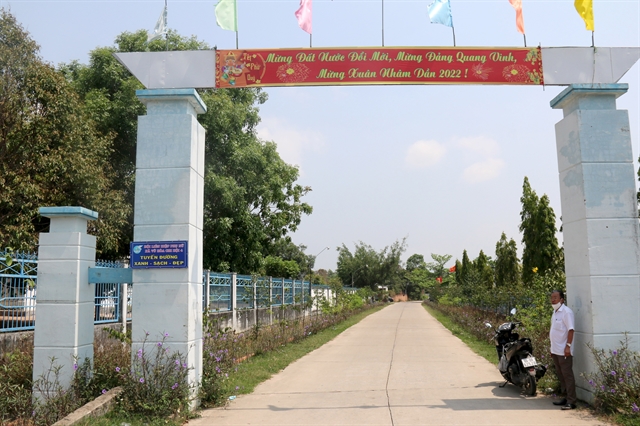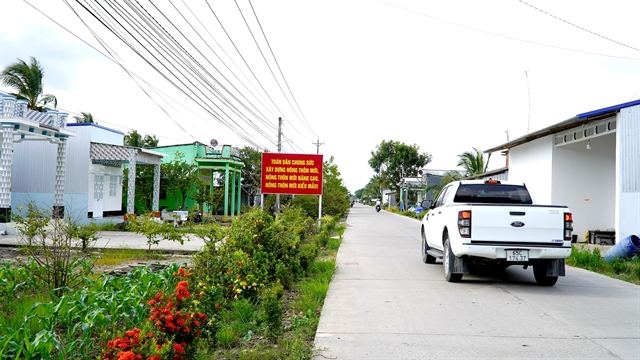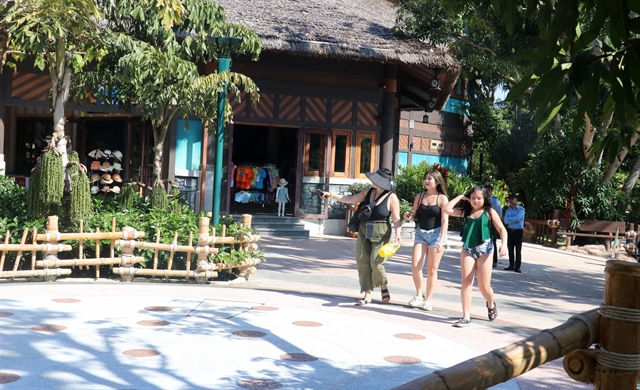 Society
Society

 |
| A rural road in Vĩnh Phong, a new-style rural commune in Kiên Giang Province’s Vĩnh Thuận District, is paved with cement and planted flowers. – VNA/VNS Photo Văn Sĩ |
KIÊN GIANG – The building of new-style rural communes in Kiên Giang Province has helped improve the appearance of rural areas and the lives of local people.
After implementing the national programme of building new-style rural areas for 10 years, the Cửu Long (Mekong) Delta province has 111 of all 116 communes recognised as new-style rural communes
New-style rural communes must meet the programme’s 19 criteria related to infrastructure, irrigation, electricity, environment, income, education, healthcare, social security, culture and others.
The province also has 19 advanced new-style rural communes, which achieve higher standards across the 19 criteria than new-style rural communes.
In new-style rural communes, roads and other infrastructure facilities have been built sufficiently and these help facilitate the lives of local people.
Gò Quao District’s Thới Quản is one of the province’s first communes recognised as a new-style rural commune in 2017 and then it was recognised as an advanced new-style rural commune last year.
Nguyễn Thanh Phong, chairman of the Thới Quản People’s Committee, said: “All inter-hamlet roads in the commune are paved with asphalt or cement and are 3 - 4 metres wide, allowing vehicles to transport agricultural products easily.”
The work of taking care of people’s health and providing schooling for children have been implemented better and the rate of households with access to clean and hygiene water has reached more than 99 per cent, he said.
Before 2015, most roads in the commune were 1.5 – 2 metres wide and unpaved.
The programme has attracted active participation of local people as they are its direct beneficiaries and they have donated land, money and labour to build infrastructure such as roads and bridges.
Phan Thu Thuỷ in Giồng Riềng District’s Ngọc Trúc Commune has donated 300 sq.m land of her orchard and VNĐ30 million (US$1,200) in cash to widen a road in front of her house.
In the past three years, she and her husband and other neighbours have walked on the road doing exercise in the morning and afternoon every day, she said.
“We feel proud of rural landscapes with beautiful trees and flowers, and trucks can travel to houses to take and deliver agricultural goods,” she said.
Lê Hữu Toàn, director of the province Department of Agriculture and Rural Development and deputy head of the province’s steering committee for national target programmes, said the programme has become an active emulation movement and has spread widely in the whole province after 10 years of implementation.
The programme has helped develop rural socio-economic infrastructure such as roads, bridges, health clinics and schools, and has created favourable conditions for locals to do agriculture production and business, he said.
The average income per capita of rural people has increased from VNĐ46.7 million ($1,900) in 2020 to VNĐ57.8 million ($2,300) in 2023, he said.
The programme has contributed to developing hundreds of farming models and many products under the country’s “One Commune - One Product’ (OCOP) programme, improved income for rural people and reduced poverty sustainably, he said.
The province aims to have five additional new-style rural communes, 12 advanced new-style rural communes and three exemplary new-style rural communes this year.
OCOP products
Kiên Giang has 269 OCOP products rated between three and five stars, according to its Department of Agriculture and Rural Development.
These products include rice, dried shrimp and fish, fermented fish, fish sauce, honey, pepper, ginger and turmeric essential oil, and soursop tea.
Nguyễn Thị Hồng Liên, head of the province’s Sub-department of Rural Development, said the development of OCOP products has exploited and promoted the potential and advantages of rural areas to improve income for locals, and contributed to restructure agriculture production in combination with developing a cottage industry, services and rural tourism.
The OCOP programme has helped develop the rural economy sustainably, manage natural resources, and preserve culture values, biodiversity, landscapes and the rural environment, she said.
Relevant departments and agencies in the province have boosted advocacy activities to advertise and promote OCOP products at fairs, exhibitions, and culture and tourism events.
The province has targeted to develop high-quality products of each locality to effectively implement the OCOP programme, and improve the quality of products that have high competitiveness for sales domestically and exporting.
It has identified to develop OCOP products in combination with developing their brand names and rural tourism.
It will develop rural tourism in Kiên Hải, U Minh Thượng, Châu Thành, Giồng Riềng, Gò Quao and Hòn Đất districts and Hà Tiên and Phú Quốc cities.
The province received 7.6 million tourists in the first eight months of the year, including 665,000 foreigners, according to its Department of Tourism. – VNS
 |
| Tourists visit Hòn Thơm Island in Kiên Giang Province’s Phú Quốc City. – VNA/VNS Photo Lê Huy Hải |




